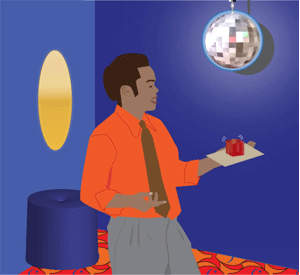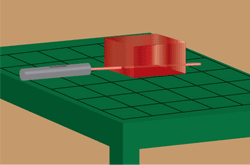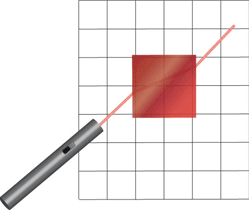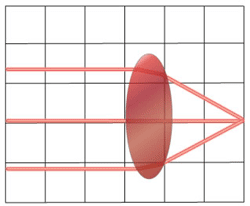Laser Jell-O
If you thought Jell-O only did funny things to your tummy then you need to see what it does to light! Come explore as light changes its path when it passes through Jell-O

Safety:
Caution:
- We will be using a low-powered Laser for this project. Do not look directly into the beam or shine it in another person’s eyes as the beam can cause eye damage.
- Boiling hot water will be used for making the Jell-O in this project. Use care when handling.
Materials:
- 1 Box red Jello or any similar brand
- Red Laser pointer
- Mixing Bowl
- Hot & Cold Water
- Measuring Cups
- 13’ X 9’ pan
- Pizza cutter and/or knife
- Graph paper
Instructions:
1. Mix Jello according to Jello "Jiggler" instructions and pour into 13 X 9 pan. Allow to cool.2. Use the pizza cutter or knife to cut a square of Jello. Don’t eat it yet.
3. Put the laser pointer on the graph paper so that the beam will point down one of the grid lines. Tape the laser in place

4. Place the square of Jello on the graph paper at a 45 degree angle to the laser beam.

5. Shine the laser through the Jello. What happens to the beam of the laser as it moves through the Jello?
6. Change the angle of the laser beam in relation to the Jello and see what happens

7. Now cut other shapes from the Jello, circles, semicircles, triangles and concave lenses.
8. What happens to the laser beam as it passes through each of these?
Questions:
- Did the laser beam do what you expected it to?
- What effect did the shape of the Jell-O have on how the laser beam traveled?
- Which Jell-O shape represented a concave lens, convex lens, and a prism?
- In what applications do you see lenses being used for and why?
What’s Going On?
The term lens can be traced back to the early 1600’s when scientists wanted a name to describe the specially shaped glass pieces they were using in their microscopes, telescopes, and eye glasses. They decided upon using the term lens which is Latin for a lentil because of the glasses resemblance to the lentil seed.
Light usually changes its path as it moves from one material to another. However, if the materials have the same index of refraction, light does not change path and the second material seems to disappear. Unfortunately one can’t see how light beams actually travel through materials such as glass because the beam can’t be seen. A light beam can only be seen when it reflects off of something like chalk dust in a room or pollen in the air. However, Jello has tiny particles in it that reflect the laser beam as it travels which allows us to see what path the beam is taking. Because red light reflects off of red surfaces but is absorbed by other colors this experiment only works if the laser is the same color as the Jello. If you want to see this further, you could use a green laser and green Jello. Red lasers are suggested because they are much cheaper than green ones.
Once you have seen how light changes direction in a square, cut the Jello into infinitely many interesting shapes. Convex and concave lenses are particularly interested because you will be able to see how the lens focuses or unfocuses light. It is even possible to find the focal point of a Jello lens. A triangle is a good way to see how light behaves in a prism.
Suggested Resources:
Ray Theory of Light
Dr. Ben Crowell, Fullerton College
Lectures in Physics
The Physics Classroom
How Stuff Works
The Physics Hypertextbook
Answers.com











